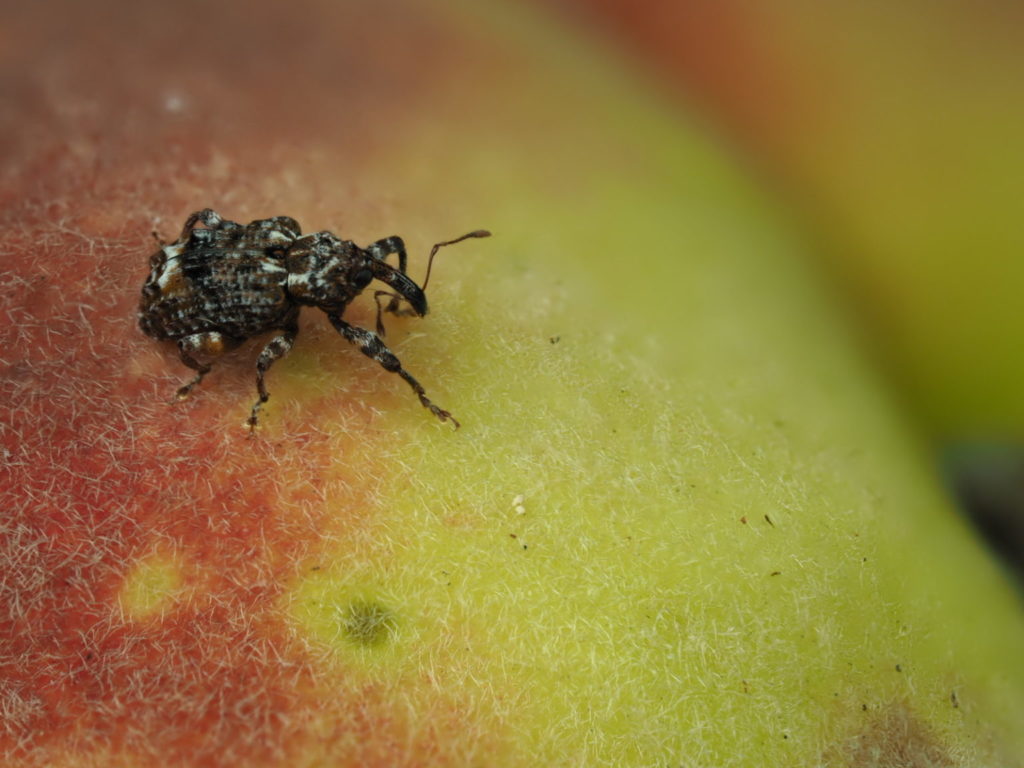
The onset of spring means preparing for insect pests if you are a fruit tree producer. Plum curculio is the most destructive insect that attacks early-season fruit.
“If you have fruiting trees, especially peaches, now is the time to ramp up your monitoring efforts for plum curculio to determine if and when management decisions will need to be made,” urged University of Georgia (UGA) College of Agricultural and Environmental Sciences peach entomologist Brett Blaauw.
Plum curculio is the most economically important pest in the commercial peach industry in Georgia, Blaauw said. Its long snout punctures young fruit during feeding and egg-laying, leaving crescent-shaped scars on the peach skin. They prefer pome and stone fruits such as apples, pears, peaches and plums.
Shuck Split
In Georgia, overwintering adults emerge and begin their migration into orchards around the time of shuck split, usually March through April. Shuck split is a critical time period for making management decisions as plum curculio targets these young fruits, and once established, can become more difficult to control throughout the growing season.
There are two generations of plum curculio each season. Adult females begin laying eggs in the spring. Within five to eight weeks, adults emerge to feed on fruit and foliage before depositing eggs and beginning a second generation.
Controlling Curculios
If unmanaged, both generations can cause significant economic losses.
Most peaches infested by plum curculio early in the season drop prematurely. Larger peaches, though infested after pit hardening begins, stay on the tree until ripe. These ripe fruits become infested with larvae and have to be discarded.
First- and second-generation adults continuously feed until cooler weather arrives, when they begin seeking overwintering sites where they will lay in wait for the next season.
Once maximum daily temperatures reach 70 degrees Fahrenheit (F) for two consecutive days from February to early March, growers can begin keeping track of and accumulating growing degree days using a base temperature of 50 F.
The period of March and April is when fruit should be protected by insecticide sprays. Summer adults emerge from the soil usually in late May through harvest of late-ripening cultivars.
Blaauw suggests making early season applications of insecticides to protect the young, developing fruits from adults laying first-generation eggs. Typically, sprays are applied between petal fall and shuck split. Two or three additional sprays at 10- to 14-day intervals are needed to assure control of the overwintered population.
For commercial production, rotate highly effective materials like phosmet, thiamethoxam, clothianidin or indoxacarb with pyrethroids, such as esfenvalerate.
For homeowners, products such as kaolin clay can be applied to trees to create a physical barrier against attack. Other tools for small-scale production are the use of fruit bags that protect growing fruit throughout the season and eliminate the need for weekly pesticide applications.
Be Proactive
Proactive measures for minimizing damage in subsequent years will begin immediately following harvest. Blaauw recommends closely mowing ground cover to reduce habitat for adults that are seeking out overwintering sites. Always be sure to clear out wild plum thickets and other alternative hosts nearby to reduce migration from outside sources.
To learn more about setting traps and monitoring for plum curculio, read Extension Circular 1224, “Plum Curculio: An Incessant Pest of Peaches.” For more information on peach management, visit the UGA Peach Blog.









